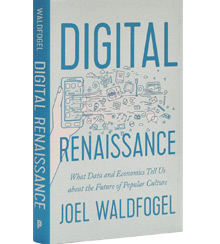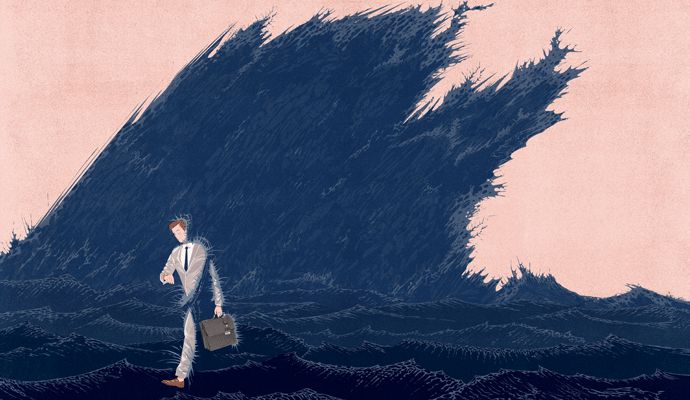Why the Digital Era Is a Boon for Pop Culture
In his new book, economist Joel Waldfogel argues that digitization is ushering in a golden age for both producers and consumers of entertainment.
Digital Renaissance: What Data and Economics Tell Us about the Future of Popular Culture
by Joel Waldfogel, Princeton University Press, 2018
A version of this article appeared in the Spring 2019 issue of strategy+business.
Cultural pessimism, like wearing black, is always in fashion, and the Internet has made it easier than ever to bemoan the crassness of popular tastes. Spend enough time on Twitter, and you may be tempted to conclude that the digital revolution is destroying not just culture, but civilization.
Joel Waldfogel begs to differ, at least about the culture part. The title of his compelling new book — Digital Renaissance — betrays his optimistic thesis, which he backs up with some creative data-sleuthing. Waldfogel, an economist, makes no grand claims about whether the Internet is destroying the social fabric or the body politic. But his argument about popular culture is straightforward: With respect to movies, TV, music, and books, the Internet has brought us more and better works than we had previously, and it has made them far more readily available to consumers of all means.
Waldfogel’s book offers reassurance to those who fear that the new regime of ones and zeros is undermining cultural production. But his assessment will be far less comforting to denizens of the traditional cultural-industrial complex, not to mention the cultural pessimists bewailing its decline. The digital revolution has overturned, or at least diminished, a variety of erstwhile industry titans, and more incumbents are likely to suffer. Then there’s the matter of safeguarding intellectual property ownership. Theft is illegal and wrong, of course, but Digital Renaissance is a book-length refutation of those who insist that, without greater protections for intellectual property, musicians, authors, and other creative types will stop creating. In fact, Waldfogel finds the very opposite to be the case. In the age of sharing, streaming, and easy copying, we live amid unprecedented cultural plenty. “We should judge the health of a creative regime by the works created, and their value to users, and not by the revenue of incumbent producers,” he writes.
Take movies, for example. In 2000, Waldfogel reports, 1,160 U.S. films were released. By 2016, that number had nearly tripled, to 3,412. Other countries have seen big increases in film production as well; indeed, “the growth in new movies produced is a worldwide phenomenon,” the author says, adding elsewhere that “most of the new movies are coming from sources outside of the major studios.” And those movies can be watched on demand. Waldfogel notes that in the evanescent age of the video store, a Blockbuster outlet might have carried 2,000 titles, a figure that now seems risible: “As of June 27, 2017, there were 46,687 distinct movie titles available on at least one U.S. digital platform.”
“As of June 27, 2017, there were 46,687 distinct movie titles available on at least one U.S. digital platform.”
But is anybody really paying attention to all this stuff? And is there quality in all this quantity? Reliable data on a subjective measure such as quality is hard to come by. But the endlessly resourceful author, a professor at the University of Minnesota’s Carlson School of Management, has come up with some useful proxies. For example, he finds that the box office revenue of a film is correlated with the number of IMDb user ratings for that film. So he constructs an index of movie success based on a film’s share of ratings in the year of its release. The recent trend has mostly been upward. Using data from such online sources as Rotten Tomatoes, Metacritic, and the Internet Archive’s Wayback Machine, Waldfogel gets at the question of quality from different angles (none perfect). The answer is always the same: Movies are getting better, driven at least in part by the flood of new films unleashed by the digital revolution.
Waldfogel, whose last book, Scroogenomics, was about the wastefulness of Christmas presents, isn’t the first to defend the new digital regime as a cultural cornucopia rather than a grim reaper laying waste to the arts. Chris Anderson, in his 2006 book The Long Tail, contended that the Internet has enabled commerce to answer the demand for a much broader distribution of products than had previously been serviceable. Which is a salutary turn of events for all concerned, especially in the arts. Waldfogel’s book supports Anderson’s broad argument without proving or disproving the latter’s contention that sales of long-tail works, in the aggregate, may equal or eclipse those of blockbusters.
Of course, there are omissions. Waldfogel pays no attention to the tragic fate of newspapers; mostly ignores opera, classical music, and jazz; and at one point claims to remember Mr. Peabody, the canine cartoon genius, as appearing on the Underdog show, when in fact he was on Rocky and Bullwinkle. But the author is a dogged (sorry) and imaginative researcher who, instead of merely expounding passionately on one side of the argument or the other, presents data in support of his conclusions.
“Digital doomsayers should lighten up,” Waldfogel concludes. “Sure, there’s lots of bad new stuff out there. Some find it disappointing that so many people buy Fifty Shades books and watch ‘Keeping Up with the Kardashians.’” But such worthwhile novels as Still Alice, The Martian, and The Wake were self-published, because the gatekeepers didn’t think them worthy. It’s not surprising that mainstream publishers missed these works given that in so many creative fields, it’s so very difficult to know what will succeed in the marketplace. In addition to a wider variety of books, the author writes, digitization has given us “a mountain of critically acclaimed films, the best music vintages in over a quarter century, and a new golden age of television.”
It may be that many of the complaints about the digital media onslaught have more to do with the impact on established businesses than on the quality of our culture. The digital revolution has radically rearranged revenue streams in the entertainment and media businesses, depending on how easily any article of cultural production can be shared and downloaded. On this basis, the big losers are the major record labels, because songs are so amenable to distribution on the Internet. Book publishers are continuing to see modestly rising sales. The revenues of large Hollywood players have soared thanks to the new digital platforms, although much of this money, the author reports, has been lost to bidding wars for talent. The big winners in this renaissance, aside from Amazon, Apple, Netflix, and similar platforms, appear to be the outsiders who couldn’t get past the gatekeepers of old, and consumers of culture, who get much more for less.
The lesson for business, perhaps, is that sooner or later, the customer usually wins. Firms can do likewise only if they embrace the revolution.
Author profile:
- Daniel Akst, a frequent contributor to the Wall Street Journal, is a writer in New York’s Hudson Valley.




